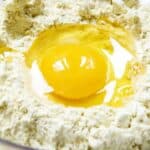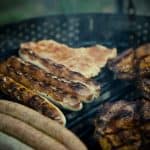This dairy-free, vegan, high-fiber, gluten-free chickpea flour pasta has only two ingredients and is perfect for serving with all of your favorite pasta sauces! Use the best flour for pasta or dried or frozen chickpea pasta right away or save it for months!
Though I’ve already shared vegan (non-gluten-free) pasta, oat pasta, and red lentil pasta (gluten-free with vegan option) – this chickpea flour pasta is gluten-free and vegan, with only two ingredients (with an optional third). You can make this chickpea pasta from scratch in just 20 minutes, then cook it for another 7-8 minutes for a delicious, nutritious pasta dish any day of the week!
I first shared the process for making chickpea flour pasta almost a year ago, with the intention of using it to make chickpea pasta one day. I’m so glad I finally took the plunge, even if it took a little longer than I anticipated.
Chickpea flour pasta is one of the “free-from” pasta options that has become increasingly popular in recent years, and it’s easy to see why. It’s low-cost, high-protein, high-fiber, nutrient-dense, and delicious. But who knew it would be so simple to make it at home?!
The best part is that you can make homemade pasta in a variety of shapes: ribbon noodles, bows, disks, and so on. I went with a combination of gnocchetti and shell shapes below.
Ingredients For Chickpea Flour Pasta
- Chickpea Flour – I use homemade chickpea flour pasta (also called gram flour) – but feel free to use store-bought.
- Water – use tap or filtered water- whichever you prefer. Using slightly warm water is best but not 100% necessary.
Optional Ingredients
- Tapioca flour – will help to yield a more malleable dough. Replace around 1/4 cup of the chickpea flour with tapioca flour and optionally add in the xanthan gum (mentioned below) for dough that’s easier to work with (best if you want to create thin noodles and pasta shapes that could cause the gluten-free dough to crumble.
- Xanthan Gum – I specifically made this pasta with just chickpea and water to prove that it’s possible. However, the dough is quite fiddly – if you want it to be a little easier to work with (thus easier to shape to other types of pasta), you may want to add 1 tsp xanthan gum (which mimics the properties of gluten somewhat).
- Salt – just a pinch of salt can help enhance the flavor of this homemade chickpea pasta. However, I’ll usually omit it in the dough and salt the pasta while cooking and within the sauce/accompaniments.
How To Make Chickpea Flour Pasta
STEP 1: Prepare The Chickpea Flour Dough
You can do this process on a work surface, within a bowl, or even with a stand mixer. Combine the flour and water and form a dough, kneading well to obtain a uniform texture. Though this chickpea flour pasta doesn’t contain gluten, kneading is still important for a smooth dough.
Form into a ball and then set the dough aside in a covered bowl/ wrapped in cling film for 10-15 minutes to rest. Technically, as this pasta doesn’t contain gluten, I’m not sure this resting step is necessary, but I like to think that the extra time for the flour to hydrate makes for a slightly stronger dough, so I like to rest it for a little while at least.
STEP 2: Shape/Chor Your Homemade Chickpea Pasta
You can shape/chop the oat flour pasta either by hand with a rolling pin or a pasta machine.
First, divide the dough into 4-6 pieces – this will make it more manageable to work with as you roll each section into pasta sheets.
Dust your work surface with a little extra chickpea flour pasta, and then use a rolling pin to roll out the pieces into a thin long strip. If you want to do this by hand, continue to roll until you reach your desired thickness – I usually aim for around 3mm when hand-rolling.
Alternatively, you can use a pasta machine, feeding it through from the thickest section, working your way to your desired thickness.
For tagliatelle/pappardelle style noodles, flour the dough sheet well, roll it up, and then slice into noodles of your desired thickness. Feel free to trim off the uneven edges first.
This method is easiest to do with the additional xanthan gum and/or tapioca starch. With just flour and water, roll the sheet out flat on the table and cut the noodles as it lays flat, rather than rolled up.
This time around, I decided to make a simple round pasta shape somewhat between gnocchetti and shell-shapes (it might have a name, but I’m not sure what it is). I first used a small round cutter to cut out lots of disks, then used a fork to roll them over, pinching two sides in to connect (refer to images).
There is a wooden pasta tool you can use instead of the fork, but I found the fork easier for this chick flour pasta dough.
At this point, you can either spread them across a tray and leave them to dry out (or do so with a dehydrator) or proceed with how to cooking the chickpea flour pasta!
Was this helpful?
Hi there! I’m a food enthusiast and journalist, and I have a real passion for food that goes beyond the kitchen. I love my dream job and I’m lucky enough to be able to share my knowledge with readers of several large media outlets. My specialty is writing engaging food-related content, and I take pride in being able to connect with my audience. I’m known for my creativity in the kitchen, and I’m confident that I can be the perfect guide for anyone looking to take their culinary journey to the next level.







